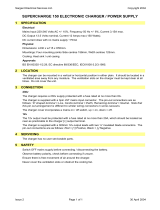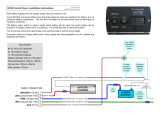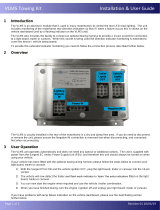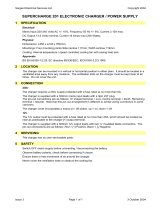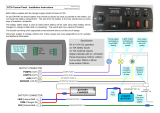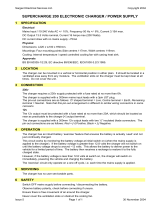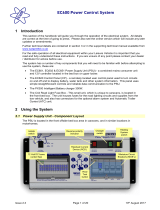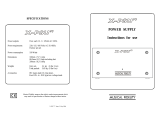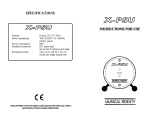Page is loading ...

EC400 / EC450 series Power Control System
E
C
4
5
0
Issue 1 Page 1 of 13 12
th
June 2011
1 Introduction
This section of the handbook will guide you through the operation of the electrical system.
Further technical details are contained in section 3 or in the supporting dealer technical manual
available from www.sargentltd.co.uk
For the safe operation of all electrical equipment within your Leisure Vehicle it is important that you
read and fully understand these instructions. If you are unsure of any point please contact your dealer
/ distributor for advice before use.
The system has a number of key components that you will need to be familiar with before attempting to
use the system, these are:
· The EC400 / EC450 series Power Supply Unit (PSU) - a combined mains consumer unit
and 12V controller located in the front locker or bed box area. On locker mounted caravan
versions this unit also contains the provision for the Radio/CD head unit. The EC400 /
EC450 series of power supply units include the EC400 range (horizontal units) and the
EC450 range (vertical units), further details are contained later in this document.
· The EC400 / EC450 series Control Panel (CP) - a remotely located user control panel used
to turn circuits on and off and to display battery and water tank information. This panel uses
simple straightforward controls and reliable data communication to the PSU.
· Road Light Fuse Box - This small unit, which is unique to caravans, is located in the front
bed box. The unit houses fuses for the road lighting circuits and supplies from the tow
vehicle, and also has connectors for the optional alarm system and Automatic Trailer Control
(ATC) unit.
2 Using the System
The PSU is located in the front offside locker area or front bed box in caravans, and in similar locations
in motorhomes.
2.1 Power Supply Unit - Models
A number of different PSU versions are used within the system and are shown above. The operation
of each model is very similar and is detailed below.

EC400 / EC450 series Power Control System
E
C
4
5
0
Issue 1 Page 2 of 13 12
th
June 2011
2.2 Power Supply Unit – Component Layout
230V Components
Red indicator – Reverse polarity indicator, lights up when the 230V supply polarity is reversed.
Green push switch – Charger switch, this switch turns the 12V battery charger on or off. “In” is
on “out” is off.
Amber push switch – Space heater switch, this switch turns the 230V supply to the space
heater / combination heater / central heating system on or off. In is on out is off.
Clear push switch – Water heater switch, this switch turns the 230V supply to the separate
water heater on or off. In is on out is off.
Note, If the vehicle contains a combined space & Water heater then this button is not used.
Black lever switch, far left – Residual Current protection Device
(RCD) and main 230V on / off switch.
Yellow button, far left – RCD test button.
Red lever switches, right – 3 x 10A Miniature Circuit Breakers
(MCB). Please note that installations with a 3KW Alde heating
system will have 2 x 10A and 1x16A MCB’s.
12V Components
Black push switch, far left – System shutdown switch, this
switch turns the power control system on or off. In is on
out is off.
Yellow push button, top right – Select button, this button is
used to scroll through the display items on the LCD screen.
Red push button, bottom right – Set button, this button is
used to change the setting of the displayed item on the
LCD screen.
12V DC circuit protection fuses. Fuse number 1 is top left; fuse
number 14 is bottom, right. See section 3.5 for full fuse allocation
details.
2.3 Activating the System
The EC400 / EC450 system has a shutdown feature that should be used when the vehicle is in storage
or is not being used for long periods of time. This allows the leisure electronics to be turned off when
not required to save battery power. When in the off state the alarm and tracking system supplies are
still active, most other supplies are turned off.
Before using the system please ensure the shutdown switch is in the system on position (button in).

EC400 / EC450 series Power Control System
E
C
4
5
0
Issue 1 Page 3 of 13 12
th
June 2011
2.4 Connecting to the Mains 230V supply and Safety checks
For your safety it is IMPORTANT that you follow these connections instructions each time your Leisure
Vehicle is connected to a mains supply. This section assumes that the system is complete and that a
Leisure battery has been installed (see 3.4).
A) Ensure suitability of the Mains Supply. Your Leisure Vehicle should only be connected to an
approved supply that meets the requirements of BS7671 or relevant harmonised standards. In
most cases the site warden will hold information regarding suitability of supply. If using a generator
you also need to comply with the requirements / instructions supplied with the generator. Please
note that some electronic generators may not be compatible with your leisure system. Further
generator operational information is contained elsewhere in this manual.
B) Switch the PSU internal Power Converter OFF. Locate the green ‘Charger’ power switch on the
PSU and ensure the switch is in the off position (button out) before connection to the mains supply.
C) Connect the Hook-up Lead. Firstly connect the supplied hook-up lead (orange cable with blue
connectors) to the Leisure Vehicle and then connect to the mains supply.
D) Check Residual Current Device operation. Locate the RCD within the PSU and ensure the RCD
is switched on (lever in up position). Press the ‘Test’ button and confirm that the RCD turns off
(lever in down position). Switch the RCD back to the on position (lever in up position). If the test
button failed to operate the RCD see section 3.10.
E) Check Miniature Circuit Breakers. Locate the MCB’s within the PSU (adjacent to the RCD) and
ensure they are all in the on (up) position. If any MCB’s fail to ‘latch’ in the on position see section
3.10.
F) Turn the PSU ON. Locate the black ‘Shutdown’ button and ensure it is in the on position (press
button in). Locate the green ‘Charger’ switch on the PSU and turn to the on position (press button
in). The charger switch will illuminate when turned on.
G) Check correct Polarity. Locate the ‘Reverse polarity’ indicator on the PSU and ensure that the
indicator is NOT illuminated. If the indicator is illuminated see section 3.10.
H) Check operation of equipment. It is now safe to operate the 12v and 230v equipment.
2.5 Control Panel - Component Layout
Depending on your type of vehicle (caravan or motorhome) the control panel will vary in specification.
Not all features are present in all vehicles. Please refer to the following diagrams to identify your
control panel.
Motorhome Control Panels
EC467

EC400 / EC450 series Power Control System
E
C
4
5
0
Issue 1 Page 4 of 13 12
th
June 2011
EC462
Caravan Control Panels
EC451
EC447 EC442
2.6 Control Panel Operation
· Power Button. Press the power button to turn the leisure power on. Press the button again
to turn the power off. The adjacent LED will illuminate when the power is on, and also the
voltage of the selected battery will be displayed on the voltage gauge.
· Pump Button. With the power on, press the pump button to turn the water pump on. Press
the button again to turn the pump off. The adjacent LED will illuminate when the pump is on,
and also the level of the water tank will be displayed on the water gauge.
· View Levels. To display the battery voltage levels and the water tank levels on the control
panel gauges, press the levels button. The display will remain illuminated for 10 seconds. It
is possible to lock the display ‘on’ to allow continuous display. This can be achieved by
pressing and holding the view levels button for 2-3 seconds until you hear a beep. To turn
this locked feature off, either press and hold the view levels button again for 2-3 seconds or
turn the power off and back on.
· Battery Select. By default, the leisure battery is selected as the power source if no mains
supply is present, or as the battery to be charged when the mains supply is available. To

EC400 / EC450 series Power Control System
E
C
4
5
0
Issue 1 Page 5 of 13 12
th
June 2011
change the selected battery, press the vehicle battery select button. The selected battery is
indicated by an LED adjacent to the caravan or car logo (for caravans) or the LED’s situated
to the front (vehicle) or rear (leisure) of the motorhome logo (for motorhomes).
· Mains on indication. When connected to a 230v supply the LED with a “lightning strike”
shown will be illuminated.
· Charging when the vehicle engine is running. When the vehicle engine is running both
the vehicle battery and the leisure battery LED’s will flash in unison to indicate that they are
connected together and are being charged by the vehicle.
· Tank Fill Button. For some caravans, with the power on, press the tank fill button to turn the
external filler pump on or off. Please ensure you switch the fill button off when the external
tank is empty to prevent damage to the pump.
· Cabin Lights Button. For motorhomes, with the power on, press the cabin lights button to
turn the main lighting supply on or off.
· Awning Light Button. For motorhomes, with the power on, press the awning light button to
turn the awning light on or off.
· Frost Protect Button. For motorhomes if / when fitted, with the power on, press the frost
protect button to turn on the water tank heating system. The adjacent LED will illuminate to
show that the tank heating system is on.
2.7 Operation while driving
The EC400 / EC450 system is designed to shutdown parts of the system while the engine is running.
This is to meet Electro Magnetic Compatibility (EMC) regulations and to ensure the safe operation of
the caravan or motorhome. This is indicated by the two battery LED’s flashing together.
Please ensure the system shutdown switch on the PSU is in the “on” (button in) position before driving
(see 2.3). This will ensure the electronic system is active and will therefore be able to control the
charging process, supply the refrigerator and monitor other system circuits.
On motorhomes if / when fitted, designated 12v sockets, en-route reading lights and en-route heating
will remain operational while the engine is running.

EC400 / EC450 series Power Control System
E
C
4
5
0
Issue 1 Page 6 of 13 12
th
June 2011
3 System Technical Information
The following section provides further technical information relating to the electrical system. You can
also access the supporting technical manual from www.sargentltd.co.uk
3.1 Residual Current Device & Miniature Circuit Breakers
Residual Current
Device (RCD)
Miniature Circuit
Breakers (MCB’s)
RCD
Test
button
The Residual Current Device (RCD) is basically provided
to protect the user from lethal electric shock. The RCD will
turn off (trip) if the current flowing in the live conductor
does not fully return down the neutral conductor, i.e. some
current is passing through a person down to earth or
through a faulty appliance.
To ensure the RCD is working correctly, the test button
should be operated each time the vehicle is connected to
the mains supply (see section 2.4)
The Miniature Circuit Breakers (MCB’s) operate in a similar
way to traditional fuses and are provided to protect the
wiring installation from overload or short circuit. If an
overload occurs the MCB will switch off the supply. If this
occurs you should investigate the cause of the fault before
switching the MCB back on.
The following table shows the rating and circuit allocation for the three MCB’s
MCB Rating Output Wire Colour Description
1 10 Amps White 230v Sockets
2 10 Amps White (Yellow for heater) Extra 230v Sockets / Space Heater
2 16 Amps Yellow Alde heating (EC470 PSU Only)
3 10 Amps Black (Blue for water heater)
Fridge / Water Heater /
12v Charger (internally connected)
3.2 Battery Charger
The EC400 / EC450 system incorporates an intelligent three-stage battery charger / power converter.
During stage 1 the battery voltage is increased gradually while the current is limited to start the
charging process and protect the battery. At stage 2 the voltage rises to 14.4V to deliver the bulk
charge to the battery. When the battery is charged, the voltage is decreased at stage 3 to 13.6V to
deliver a float charge to maintain the battery in the fully charged state. The charger can be left
switched on continuously as required.
The battery charger / power converter also provides power to the leisure equipment when the mains
supply is connected. This module supplies DC to the leisure equipment up to a maximum of 25 Amps
(300 Watts), therefore the available power is distributed between the leisure load and the battery, with
the leisure load taking priority as per the following example:
Leisure load Available power for battery charging
5A 20A
10A 15A
15A 10A
20A 5A
WARNING
Under heavy loads the Charger case may become hot. ALWAYS ensure the ventilation slots have a
clear flow of air. Do not place combustible materials against / adjacent to the Charger

EC400 / EC450 series Power Control System
E
C
4
5
0
Issue 1 Page 7 of 13 12
th
June 2011
3.3 Smart Charging
On EC468 and EC469 PSU’s, the system incorporates a smart charge feature, which monitors both
leisure and vehicle batteries and automatically adjusts and directs the charger power (and solar power
if a solar panel is installed) to maintain the leisure and vehicle batteries at an optimal level.
3.4 Leisure Battery
A) Type / Selection
For optimum performance and safety it is essential that only a proprietary brand LEISURE battery is
used with a typical capacity of 75 to 120 Ah (Ampere / hours). A normal car battery is NOT suitable.
This battery should always be connected when the system is in use.
The PSU is configured to work with standard lead acid leisure batteries, and in most cases is also
compatible with the latest range of Absorbed Glass Matt (AGM) batteries. Before fitting non-standard
batteries please check that the charging profile described in 3.2 is suitable for the type of battery by
referring to the battery documentation or battery manufacturer.
Some vehicle installations can cater for two leisure batteries connected in parallel. In these cases it is
recommended that two identical batteries are used.
The battery feed is fitted with an inline fuse between the battery and the electrical harness, and is
usually located immediately outside the battery compartment or within 500mm of the battery. The
maximum rating of this fuse is 20A per battery. If a single battery is fitted to a motorhome, this fuse
may be increased to 40A, however if two batteries are fitted each battery should be fused at a
maximum of 20A.
B) Installation & Removal
Always disconnect the 230v mains supply and turn the PSU green charger switch to the off position
(button out) before removing or installing the battery.
When connecting the battery, ensure that the correct polarity is observed (black is negative [-] and red
is positive [+]) and that the terminals are securely fastened. Crocodile clips must not be used.
WARNING
Explosive gases may be present at the battery. Take care to prevent flames and sparks in the vicinity
of the battery and do not smoke.
C) Operation / Servicing
Under normal circumstances it should not be necessary to remove the battery other than for routine
inspection of the terminals and “topping up” of the battery fluid where applicable. Please see
instructions supplied with the battery.
Note: Do not over discharge the battery. One of the most common causes of battery failure is when
the battery is discharged below the recommended level of approximately 10v. Discharging a battery
below this figure can cause permanent damage to one or more of the cells within the battery.
To prevent over discharge, the EC400-450 system incorporates a battery protect circuit that warns the
users and then disconnects the batteries when they fall below set values.
If the power is turned on and the leisure battery level falls below 9V a warning beep will be heard and
the leisure battery gauge 10V LED will flash. To cancel the warning, press the levels button.
If the power is turned on and the vehicle battery level falls below 10.9V a warning beep will be heard
and the vehicle battery gauge 10V LED will flash. To cancel the warning, press the levels button.
These warnings will not be repeated unless the power switch is turned off and on again. This is to
ensure the warning does not become a nuisance.

EC400 / EC450 series Power Control System
E
C
4
5
0
Issue 1 Page 8 of 13 12
th
June 2011
Battery
Voltage
cut off
Action after cut off Notes
Vehicle 10.9v
Battery selection is
changed from Vehicle
battery to Leisure
battery. If the leisure
battery is below 9v then
a further warning will
occur (see below).
This cut off level is designed to protect the vehicle
battery from over discharge. The 10.9v level
ensures there is sufficient power in the battery to run
the vehicle electronics and start the vehicle. This
cut off only applies to power drawn from the battery
by the leisure equipment; it will not protect the
battery if you leave vehicle circuits switched on,
such as the road lights.
Leisure 9v Power is turned off
This is an emergency cut off level to protect the
battery from severe damage. You should not rely on
this cut off level during normal operation, but
manage your power consumption to a discharge
level of 10v.
This cut off only applies to power drawn from the
battery by the leisure equipment that is controlled by
the control panel power switch; it will not protect the
battery from discharge by permanently connected
equipment.
3.5 12 Volt DC Fuses
WARNING
When replacing fuses always replace a fuse with the correct value. NEVER replace with a higher value /
rating as this could damage the wiring harness. If a replacement fuse ‘blows’ do not keep replacing the
fuse as you could damage the wiring harness. Please investigate the fault and contact your dealer.
The following table shows the fuse allocation for the 15 fuses fitted to the PSU. Please note that fuses
are dependant on PSU versions, so not all fuses may be present.
Fuse Rating Fuse Colour Description
1 20 Amps Yellow * Motorhome Fridge 12V
2 15 Amps Blue * Motorhome Towing
3 7.5 Amps Brown * Motorhome Marker Lights
4 15 Amps Blue * Motorhome Fridge D+
5 10 Amps Red Extractor Fans / Heating Systems
6 10 Amps Red 12V Sockets / TV Amp / ***Radio
7 10 Amps Red Front Internal Lights
8 10 Amps Red Water Pumps / Toilet
9 15 Amps Blue * Electric Step
10 10 Amps Red * Motorhome Tank Heaters
11 10 Amps Red ** Auxiliary Supplies
12 5 Amps Tan Electronics / Fridge / Alarm
13 5 Amps Tan Oven Ignition / * Water Heater
14 10 Amps Red Rear Internal Lights
15 25 Amps Clear Charger (fitted internally to PSU)
* Where Applicable / When
Fitted
** Motorhome Awning / Entry lights / Map
lights / Enroute Heating / Compressor
Fridge / Travel Skts / Bathroom lights
*** Caravan Radio Supply /
Motorhome Bathroom lights

EC400 / EC450 series Power Control System
E
C
4
5
0
Issue 1 Page 9 of 13 12
th
June 2011
The following table shows details of the fuse(s) located at the Leisure battery. See also 3.4A
Fuse Rating Fuse Colour Description
Battery 1 20 Amps Yellow Fuse remotely located near battery
Battery 2 20 Amps Yellow Fuse remotely located near battery 2 (where fitted)
The following table shows details of the fuse(s) located at the Road Light fuse box (caravans only)
Fuse Rating Fuse Colour Description
1 20 Amps Yellow Fridge Supply 12V
2 5 Amps Tan Left Hand Tail Lights
3 5 Amps Tan Right Hand Indicators
4 5 Amps Tan Fog Lights
5 Spare location
6 20 Amps Yellow Car Battery Supply 12V
7 5 Amps Tan Right Hand Tail Lights
8 5 Amps Tan Left Hand Indicators
9 7.5 Amps Brown Stop Lights
10 5 Amps Tan Reverse Lights
3.6 Solar Charge Management
EC468 and EC469 PSU’s incorporate a built-in solar charge management feature, which will control
the input from a separate solar panel and regulator. Depending on the charge state of the batteries,
the solar power will be directed to the required battery, and continuously monitored to ensure optimum
operation. For this system to operate intelligently, the shutdown button should be left switched on. If
the shutdown button is turned off then the solar panel will charge the vehicle battery only.
3.7 System Status and Configuration display
On the EC449, 468 & 469 PSU, the unit contains an LCD display and two control buttons that allow
system information to be viewed or settings changed.
Press the top yellow ‘select’ button to change the item being viewed. Press the bottom red ‘change’
button to change the setting.
Both buttons work on a continuous loop, so if you want to return to an item or setting keep pressing the
button until the required item is reached.
The EC468 and EC469 PSU’s also contain a status display unit that can be used to view system
information. Press the top yellow ‘select’ button to change the item being viewed.
3.8 Water System Operation
The control panel pump button operates the internal (onboard) water pump. This pump will draw
water from the internal (onboard) water tank (if fitted) or the external water inlet, depending on the
position of the manual supply selector valve.
The system also incorporates a separate powered water inlet that can be used with an external
filler pump to fill the internal (onboard) water tank (if fitted).
The water tanks (fresh & waste, where fitted) incorporate a level warning feature to warn the user
when the fresh water level drops below 25% or when the waste water level reaches 100%.
If the water pump power is turned on and the fresh water level drops to below 25% a warning beep will
be heard and the fresh gauge empty LED will flash. To cancel the warning, press the levels button.
If the water pump power is turned on and the waste water level rises to full (100%) a warning beep will
be heard and the waste gauge full LED will flash. To cancel the warning, press the levels button.

EC400 / EC450 series Power Control System
E
C
4
5
0
Issue 1 Page 10 of 13 12
th
June 2011
These warnings will not be repeated unless the water pump power switch is turned off and on again.
This is to ensure the warning does not become a nuisance.
3.9 Frost Protection
On vehicles fitted with water tank frost protection, the control panel frost protect switch can be used to
turn the feature on or off.
With protection on, the system monitors the tank water temperature and water level and will control the
tank heaters accordingly. If the fresh or waste water levels are less than 25% the appropriate heater
will be turned off to prevent overheating or damage to the element.
There are two types of system employed, both working in a very similar way. One system uses
heaters with built-in thermostats; the other uses separate temperature probes in the tank. Both types
switch on at 4-5C and off at 8-10C
3.10 Electric Step Operation
On vehicles fitted with an electric step, this is operated by a button near the entry door. Press and
release the button to move the step in or out. One press of the button will move the step out, a further
press will move the step in again.
If the engine is started the step will move in automatically, after a short warning buzzer. If this
operation fails due to an obstacle a buzzer will sound continuously to warn that the step is still out, and
therefore requires your attention.
3.11 Warnings and Alerts
If the vehicle engine is started whilst the caravan or motorhome is connected to the 230v supply, a
warning beep will be heard. This is to warn you to remove the 230v supply before driving away.
When the vehicle engine is running both the vehicle battery and the leisure battery LED’s will flash in
unison to indicate that they are connected together and are being charged by the vehicle.
Step operation (motorhomes only), if the engine is started with the step in the out position, the step will
move in automatically, after a short warning buzzer. If this operation fails due to an obstacle a buzzer
will sound continuously to warn that the step is still out, and therefore requires your attention.
Low water level and waste tank, if the fresh water level drops to below 25% a warning beep will be
heard and the fresh gauge empty LED will flash. To cancel the warning, press the levels button. If the
waste water level rises to full (100%) a warning beep will be heard and the waste gauge full LED will
flash. To cancel the warning, press the levels button.
Low voltage warning and cut off, if the power is turned on and the leisure battery level falls below 9V a
warning beep will be heard and the leisure battery gauge 10V LED will flash. To cancel the warning,
press the levels button. If the power is turned on and the vehicle battery is selected (being used) and
the level falls below 10.9V a warning beep will be heard and the vehicle battery gauge 10V LED will
flash. To cancel the warning, press the levels button.
3.12 Common Fault Table
Fault Possible Cause Proposed Fix
Connecting lead between
the site and Leisure
Vehicle not connected
Check and connect lead as per 2.4C
RCD switched off Reset RCD as per 2.4D
RCD not operating
correctly
Check supply polarity; if the RCD continues to fail contact your Dealer
as there is probably an equipment or wiring fault.
MCB switched off
Reset MCB by switching OFF (down position) then back ON (up
position), if the MCB continues to fail contact your Dealer as there is
probably an equipment or wiring fault.
No or deficient supply
from site
Contact site Warden for assistance
No 230 volt
output from PSU
Other fault Contact your Dealer

EC400 / EC450 series Power Control System
E
C
4
5
0
Issue 1 Page 11 of 13 12
th
June 2011
Fault Possible Cause Proposed Fix
Mains Supply reversed?
The reverse polarity light is designed to illuminate when the Live and
Neutral supply has been reversed / crossed over. If the light
illuminates there is a problem with the site supply or the cable
connecting the supply to your vehicle. The light is designed to work
on UK electrical supplies (where the neutral conductor is connected
to earth at the sub station). If you are using your vehicle outside the
UK this light may illuminate when no fault exists. In these cases
consult the site warden for advice.
Reverse Polarity
light is
illuminated on
PSU
Generator being used
‘The Reverse Polarity warning light is on when using my Generator’.
This is a normal side effect when using some types of generator.
Instead of connecting the neutral conductor to earth, some generators
centre tap the earth connection making both neutral and live
conductors 110v above earth. This 110v difference causes the neon
polarity indicator to illuminate. In most cases it is still safe to use the
generator, but please consult the generator handbook for further
information.
Control Panel has no
display
Check batteries and fuses, turn PSU shutdown switch and charger
switch on and ensure mains supply is connected.
Check control panel connecting lead at PSU and behind Control
Panel
Contact your Dealer
12v Power turns off
Battery protect feature has operated to protect the Vehicle battery
and or the Leisure battery. See 3.4C
Engine has been started, all equipment has been disconnected to
meet EMC requirements. See 2.7
Control Panel
Problems
Control Panel locked /
erratic function
Observe control panel handling instructions
Control panel software may have crashed. Reboot control panel by
turning off the PSU isolate switch. Wait 30 seconds then turn the
switch back on.
No 230v supply Check all above
Charger not switched on Turn charger switch on, switch will illuminate
Battery not connected and
/ or charged
Install charged battery as per 3.4
Power button on control
panel not switched to on
Turn power on at control panel
Battery flat / Battery fuse
blown
Recharge battery, check fuses, check charging voltage is present at
battery
Fuse blown
Check all fuses are intact and the correct value fuse is installed as
per fuse table
Equipment switched off /
unplugged
Check equipment is switched on and connected to the 12v supply
PSU overheated / auto
shutdown operated
Reduce load on system. Allow PSU to cool down. PSU will
automatically restart when cool.
No 12 volt output
from PSU
Other fault Contact your Dealer
Fuse blown Replace fuse with correct value as per fuse table.
Pump turned off Turn pump on by pressing the pump button at the control panel.
Pump not
working
Setting incorrect
Both the internal and external pump feeds are controlled from the
control panel. To alter the setting of the pump switch see section 3.8
Ensure the setting matches your desired requirement.
3.13 Contact details
Sargent Electrical Services Limited, provide a technical help line during office hours. Please contact
01482 678981 if you require technical help. For out of hour support please refer to the tech support
section of the Sargent web site www.sargentltd.co.uk

EC400 / EC450 series Power Control System
E
C
4
5
0
Issue 1 Page 12 of 13 12
th
June 2011
4 Technical Data & Approvals
4.1 Caravan Equipment – EC440,445,448,449 PSU & EC441,442,443,446,447,451
Control Panel
Outline Specification
INPUT 230v 230 Volts / 0 to 16 Amps + / - 10%
OUTPUT 230v
RCD protected, 3 x MCB outputs of 10A
Separate switched channels for water heater, space
heater and charger
INPUT 12v 2 x 20A battery inputs via 2 x 4 way connectors
OUTPUT 12v
25A total output via multiple switched channels protected
by 14 fused outputs
CHARGER
Input 220-240 Volts AC +/- 10%, Frequency 50 Hz +/- 6%,
Current 3A max.
DC Output 13.6 to 14.4 Volts nominal, Current 25 Amps
max (300 Watts).
Overall size (HxWxD) 50 x 250 x 135mm
Fixing centres 128*128mm
1.2kg
Signal INPUT
4 x Fresh water level, 1 x Engine running, plus multiple
vehicle connections
Fresh water negative sensed
Data IN / OUT
CANBUS Data communication and power to Control
Panel via 6 way connector
IP rating IP31
Operating
temperature
Ambient 0 to 35° Centigrade
PSU case temperature with full load 65° C Max
Automatic shutdown and restart
if overheated / overloaded
Dimensions
EC449, EC448 PSU
Overall size (HxWxD) 395 x 205 x 170mm
Clearances 75mm above, 50mm left & right
Weight 3.05 Kg
EC442, EC447
Control Panel
Overall size (HxWxD) 87 x 250 x 15mm
Cut-out size (HxW) 70 x 233mm
Fixing centres 130*75mm
Weight 114 g
4.2 Motorhome Equipment - EC460,465,468,469,470 PSU & EC461,462,466,467
Control Panel
Outline Specification
INPUT 230v 230 Volts / 0 to 16 Amps + / - 10%
OUTPUT 230v
RCD protected, 3 x MCB outputs of 10A
Separate switched channels for water heater, space
heater and charger
EC470 2 x 10A MCB Outputs & 1 x 16A MCB Output
INPUT 12v 2 x 20A battery inputs via 2 x 4 way connectors
SOLAR INPUT
1 x Dedicated solar panel input (20 to 100W panel) via a 2
way connector
OUTPUT 12v
25A total output via multiple switched channels protected
by 14 fused outputs
CHARGER
Input 220-240 Volts AC +/- 10%, Frequency 50 Hz +/- 6%,
Current 3A max.
DC Output 13.6 to 14.4 Volts nominal, Current 25 Amps
max (300 Watts).
Overall size (HxWxD) 50 x 250 x 135mm
Fixing centres 128*128mm
1.2kg

EC400 / EC450 series Power Control System
E
C
4
5
0
Issue 1 Page 13 of 13 12
th
June 2011
Signal INPUT
4 x Fresh water level, 4 x Waste water level, 1 x Engine
running, plus multiple vehicle connections
Fresh water negative sensed
Waste water negative sensed
Data IN / OUT
CANBUS Data communication and power to Control
Panel via 6 way connector
IP rating IP31
Operating
temperature
Ambient 0 to 35° Centigrade
PSU case temperature with full load 65° C Max
Automatic shutdown and restart
if overheated / overloaded
Dimensions
EC468, EC469 PSU
Overall size (HxWxD) 315 x 195 x 150mm
Clearances 75mm above, 50mm left & right
Weight 2.9 Kg
EC462, EC467
Control Panel
Overall size (HxWxD) 87 x 250 x 15mm
Cut-out size (HxW) 70 x 233mm
Fixing centres 130*75mm
Weight 114 g
4.3 Approvals
System: BSEN 1648-1, BSEN1648-2 compliant, BS7671: 2008 compliant
Residual Current Device: RCD 40A 30mA trip to BS EN 61008
Miniature Circuit Breakers: MCB’s type C 6000A breaking capacity to BSEN 60898
Electro Magnetic Compatibility (EMC) directive 2004/108/EC Certificate CE20071224-1
Integrated Charger: BS EN 60335-1/2.29, 2006/95EC, IEC61000-3.2/3:1995, 1.
Low Voltage Directive: 2006/95EC TUV-014900-A1, EN55022, Class B, EN55024/ Level 2
4.4 Declaration of Conformity
Equipment: Leisure Power Control System Model name: EC440,445,448,449 EC441,
442,443,446,447,451, EC460,465,
468,469,470, EC461,462,466,467
I hereby declare that the equipment named above has been designed to comply with the relevant sections of the
above referenced approvals. The unit complies with all essential requirements of the Directives.
Signed: Name: Position: Manufacturer:
Date:
I L Sargent Technical Director
Sargent Electrical Services Ltd
Unit 39, Tokenspire Business Park
Woodmansey, Beverley
East Yorkshire, United Kingdom
Whilst every effort has been made to ensure the accuracy and completeness of this document, no guarantee is given against errors or
omissions. This document may be updated / improved orver time therefore please check with your dealer / supplier for update
information or visit www.sargentltd.co.uk
/

